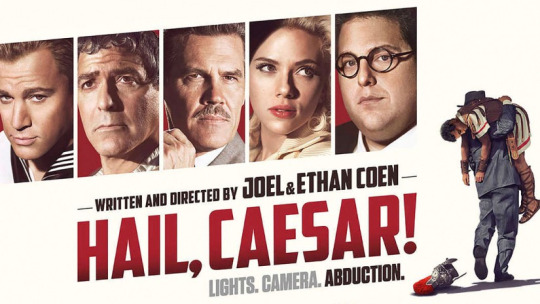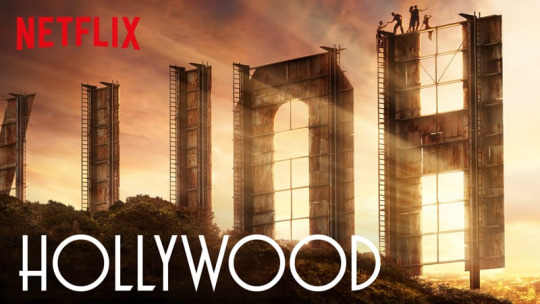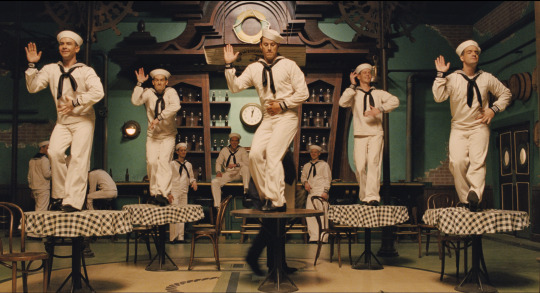#contemporaryhollywoodcinema
Text
Contemporary Hollywood Cinema - Screening Journal
Week 2 - Star Studies

This was the first time I had watched Hail! Caesar, and I was not disappointed. I loved the use of genre conventions to convey character. Eddie Mannix is shrouded in dramatic lighting, similar to that of film noir. His character’s narration over the film both conveys genre but also establishes his gritty character and his role of attempting to solve the mystery behind his prestige actor’s disappearance. Hoby, an actor in Westerns, is filmed in many shots common of that genre. However, he gradually shifts into more romantic drama cinematography as his character is forced to change his image. The clever use of genre helps establish characters but also conveys narrative elements. The satirical approach to issues of the 1950s really makes this film an enjoyable timepiece which reflects on the scandals of Old Hollywood. From the subplot of secret communists, to the loopholes of star contracts, to the celebrity status stars began to have; the Coen brothers show a clear knowledge and interest in the strange evolution of the film industry.
I enjoyed the readings this week as it showed many different ideas surrounding the star system. It was interesting to read about the differences in the star system for different genders. I already knew that most industries are unfair for women, however, I learnt more about the theoretical details of its unfairness. Laura Mulvey’s psychoanalytic insight into the male gaze was especially interesting. Her idea around scopophilia and how most female characters in classical cinema are objects to be viewed by male audiences. How subconsciously for men, femininity signifies castration anxiety; classical cinema deals with this threat by fetishising females, allowing male audiences to feel unthreatened by something they force their desires upon. Richard Dyer’s leading theories about star semiotics were very engaging. Reading into media text subtypes and how each star is a polysemy and as viewers of cinema, we engage with the stars which have meanings and ideologies we resonate with (each star’s star image). I enjoyed applying Dyer’s idea of the types of fits a star has to a role they play, it was interesting to see aspects of a star’s image be either emulated or be cast out in the characters they are cast as.
I was nervous for the first lecture as I was unsure of how well I would engage with it. Fortunately, the pre-recorded lecture was extremely thought-provoking and kept me engrossed the entire time. I was happy that Dr Artt mentioned the Netflix series Hollywood as I was reminded of it whilst watching Hail! Caesar, each respectively shows an in-depth understanding of the industry whilst highlighting the deep-rooted issues it had and still have today. The lecture mainly reaffirmed my understanding of film history, as well as expand on many concepts from the readings. I liked the highlighting of parallels in actors’ careers, like Charlie Chaplin and Ben Stiller, who both have found success in their pairing of physical comedy and romance. Christine Geraghty’s three categories of stardom were intriguing as I felt it was an interesting way to look at the careers of actors; for example, Scarlett Johansson is more a ‘performer’, whereas Tilda Swinton is definitely ‘professional’.

I really liked having clips to relate to the lecture discussions. I could see the clear transition from Chaplin’s older works to the new, more kind version of the tramp seen in The Circus. The parallel between the day-dream scene in The Circus to the repetitive imagination scene in High Fidelity shows us how the comedy genre has evolved but still has the same themes of romantic jealousy which were so common in Chaplin’s films. Singing in the Rain is such a feelgood movie, seeing this clip really brightened my day, and I may have ended up watching the entire film. I think it highlights perfectly the enigma of the star, how we as an audience will never really know the private lives of actors, and yet as fans, we are still infatuated with them. It also conveys, similarly to Hail! Caesar, how the industry will change a star’s image to fit an American ideal. This also refers back to the idea of each star being a polysemy of ideologies which we subconsciously acknowledge as audiences.

The tutorial was a great way to consolidate my learning, as well as hear my peers’ opinions. When considering the star images of Clooney, my group suggested he is someone whom mums love, a token handsome guy whose charming and quick-witted. Whereas Tilda Swinton is a professional, well-respected actress who is known for her range of quirky characters in mainly auteur films. My group and I discussed in detail how Channing Tatum was cast in this film. Usually typecast as the American dream/hero, he is instead changed into the main villain of the film, being a secret communist during the height of The Red Scare. It was definitely a selective fit for this role, and I think that that is what made his character so interesting despite the lack of screen-time. I was definitely surprised to see Tatum go from tap-dancing on a bar to being welcomed upon a Russian submarine.
0 notes